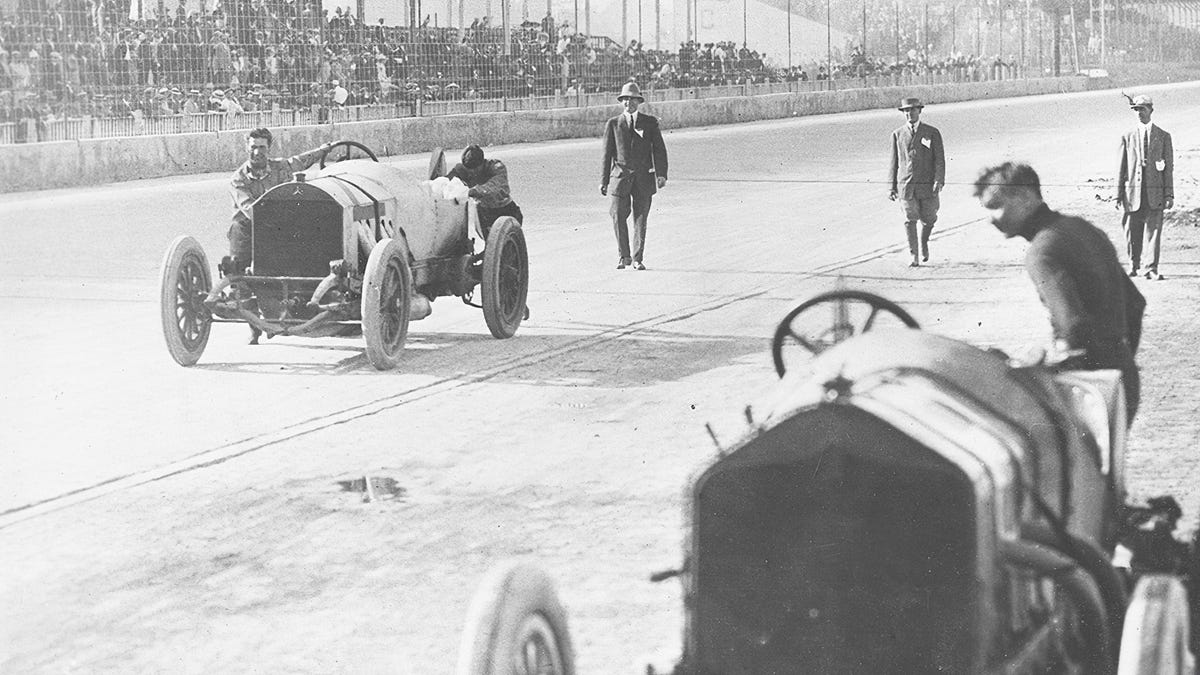Why The 1912 Indianapolis 500 is Worth Remembering in 2022

Ralph DePalma (L) and his riding mechanic Rupert Jeffkins (R) pushing their Mecedes down the front straightPhoto: Indianapolis Motor Speedway
After his record-setting pole run during time trials last Sunday, Scott Dixon finds himself in the perfect position to move up into second place on the all-time laps led list for the Indianapolis 500. To overtake Ralph DePalma for second on the list, Dixon just needs to lead 43 laps in the 200-lap race later today. Surpassing DePalma would be a landmark career achievement for the six-time IndyCar champion.
Ralph DePalma at the 1914 French Grand PrixPhoto: Bibliothèque Nationale de France
Ralph DePalma surreally held the laps led record at Indianapolis for 75 years until it was beaten by four-time Indy 500 champion Al Unser Sr. in 1987. DePalma was considered the most successful racing driver in the United States before the Great Depression. He won numerous national championships, has a career race win count in the thousands and broke the land speed record. Despite his dominant performances at the Speedway, DePalma only won the Indy 500 once. And, he is best known for the 500 that he lost.
In 1912, Ralph DePalma found himself starting on the front row for the 2nd Indianapolis 500. He was the fifth fastest qualifier for the race, but the starting order was determined when a driver’s entry was submitted. DePalma took his 1908 Grand Prix Mercedes to the lead on the third lap, and he was gone. By the 475-mile mark, DePalma had a five and a half lap lead. He simply needed to complete ten laps, and the race victory was his.
The start of the 1912 Indianapolis 500Photo: Topical Press/Hulton Archive (Getty Images)
G/O Media may get a commission
Everything collapsed with five laps to go. A connecting rod in his 9.5-liter 4-cylinder engine broke and punched a hole in the crankcase. As oil flowed out of the car and onto the track, DePalma could only hope that his Mercedes could coast the final few laps to the finish. The car came to a stop at the Turn 4 entry on lap 199 of 200. DePalma and his Australian riding mechanic Rupert Jeffkins got out and began to push the Mercedes toward the finish line.
The pair incorrectly believed it was the final lap of the 500-mile race. The huge crowd rose to their feet and roared as DePalma and Jeffkins attempted to out-push 22-year-old Joe Dawson. Dawson made up the multi-lap deficit as the leading duo willed their 2,500-pound Mercedes down the front straight. The 22-year-old won the 1912 Indianapolis 500 in view of the motorless pair.
Joe Dawson winning the 1912 Indianapolis 500Photo: Library of Congress
DePalma and Jeffkins continued to push even after Dawson won because to be eligible for prize money, a driver had to place in the top ten and complete all 500 miles. The race officials finally informed them that they still had one lap left when they reached the line. DePalma might have been physically exhausted, but he was still honorable in defeat. He waved to acknowledge the crowd’s applause and found Dawson to congratulate him on winning the 500.
Ralph DePalma led 196 of 200 laps and lost the 1912 Indianapolis 500. He would eventually win the 1915 Indianapolis 500. Dawson only led two laps and won. No one won with fewer laps led until Dan Wheldon passed a crashed J.R. Hildebrand on the final lap to win the 2011 Indy 500, 99 years later.
Ralph Mulford at the 1911 Vanderbilt CupPhoto: Indianapolis Motor Speedway Museum
Dinner and a Drive
I should mention that Ralph Mulford, the tenth place finisher in the 1912 Indy 500, actually finished 2 hours and 31 minutes behind Dawson. Mulford’s Knox had multiple mechanical issues during the day, but he was the last driver running when only nine cars had finished the race. Mulford and his crew had stopped for dinner, assuming they would be awarded tenth place. However, officials informed the team that they had to complete all 500 miles for the prize money. Mulford and his riding mechanic got back in the car with their dinner to finish the race and took turns driving as they ate their meal.



